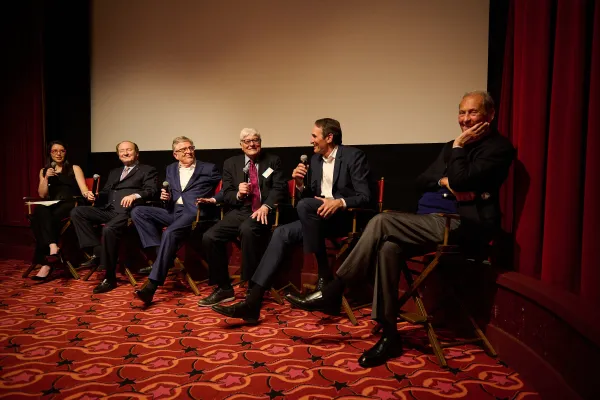
Illustration by II
Anyone taking a midday stroll along the tree-lined, tranquil streets of Brooklyn Heights in the spring of 1981 might have heard some bizarre, otherworldly sounds emanating from the brownstone on 48 Remsen Street.
The mysterious hum came from the whirring fans of a Quotron, a refrigerator-sized machine that spat out real-time stock prices for brokers and investment managers around the world. Booth had bought a two-bedroom apartment on the top floor of the house for $75,000 in 1979. In DFA’s first few months, its headquarters was Booth’s spare bedroom — which meant ejecting his brother in the process. The dining room became DFA’s first conference room, and the kitchen its inaugural staff canteen.
The Quotron — the financial industry’s dominant workhouse until the emergence of Michael Bloomberg’s eponymous data empire a few years later — was vital. But the machine was so noisy that Booth eventually had to rip out his sauna and build a soundproofed room for it. For breaks away from the “office,” Booth would take midday jogs across the nearby Brooklyn Bridge that connects the borough with lower Manhattan.
Things were little better in Chicago, but at least the Sinquefields had a tiny office at 8 South Michigan Avenue, right next to Grant Park. But the first year was spent mostly on the road, with cheap flights and cheaper hotels. During one winter visit to Honeywell, the industrial conglomerate based outside Minneapolis, Sinquefield and a colleague had to climb through a huge snowdrift to get to the hotel office of the Red Roof Inn and slip their credit card through a narrow opening in the bulletproof glass window. “You know, if we ever make any money, we are never, ever staying at a place like this again,” Sinquefield told his colleague that night.
Luckily, the US stock market rebounded in 1982, and small caps enjoyed a particularly strong year. The inaugural DFA fund returned nearly 29 percent, compared to the S&P 500’s 14.7 percent gain. That was a boon to DFA’s sales pitch, and by early 1983 its assets under management were approaching the $1 billion mark. “David Booth makes it look easy . . . Business seemed to fall in his lap,” the New York Times gushed in September that year. Klotz describes the atmosphere in those heady days of DFA as palpably exciting: “You could taste the success.”
By then, DFA had a potent weapon in its sales armory. Rolf Banz, a Swiss protégé of Myron Scholes, had been using the CRSP data compiled in Chicago to calculate the average returns of smaller stocks, and found that while they were far more volatile than the better-known blue-chip stocks, they offered far better returns in the long run. In the 1926–75 period, Banz studied, the average annual rate of return from large stocks was 8.8 percent, while smaller ones boasted an 11.6 percent rate of return.
This was startling. Not only did smaller stocks offer theoretical diversification — the only free lunch in finance, as Markowitz had shown decades earlier, and DFA’s main marketing pitch to pension funds — but they also did better than bigger stocks in the long run. “Giant payoffs from midget stocks,” Fortune trumpeted in a June 1980 article that highlighted Banz’s provisional findings. His PhD dissertation on the topic was formally published in the Journal of Financial Economics in March 1981, and showed that even adjusting for their greater volatility, small-cap stocks trounced bigger ones. Sinquefield was already aware of the study, but Fama brought the thesis to the attention of Booth, who now had firm evidence that DFA’s small-cap fund could give investors not only the ability to spread their eggs in more baskets, but greater long-term returns as well.
This was a seminal moment, setting the stage for the development of a new approach to managing money. Mindful of marketing opportunities, DFA initially dubbed them “dimensions,” but today other proponents mostly call it “smart beta” or “factor investing.”
DFA managed to keep growing, losing very few clients, partly because it had always stressed to them that stretches like this could happen. But it was an uncomfortable period that led to many awkward conversations with clients.
At one point Booth was cornered by the assistant treasurer of one big customer, who angrily grabbed his arm and snarled, “I want you to know you’re the worst performing manager we have in any asset class. Do you still believe that small-cap stocks have higher expected returns?” Booth stuck to the DFA script and replied, “We believe small-cap stocks are riskier than big-cap stocks and risk and return are related. Which part of the argument are you no longer comfortable with?” DFA eventually did make it through the lean years, but not without casualties.
Adapted from TRILLIONS: How a Band of Wall Street Renegades Invented the Index Fund and Changed Finance Forever by Robin Wigglesworth, published on October 12 by Portfolio, an imprint of the Penguin Publishing Group, a division of Penguin Random House, LLC. Copyright © 2021 by Robin Wigglesworth.





